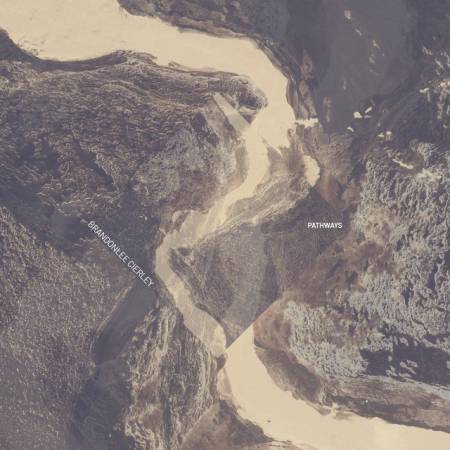I love Google Trends - they are the source of all truth. Without looking at it, I bet the term NFT is blowing up right now. Up until last week, I felt really out of the loop with NFTs and in order to actually figure it out, I ventured into writing this... Mostly for myself, but also in the hope of helping others understand what's going on with NFTs and the music industry.
update - our first NFT is live
OK, OK... but I take a quick peak at the interest in NFT:
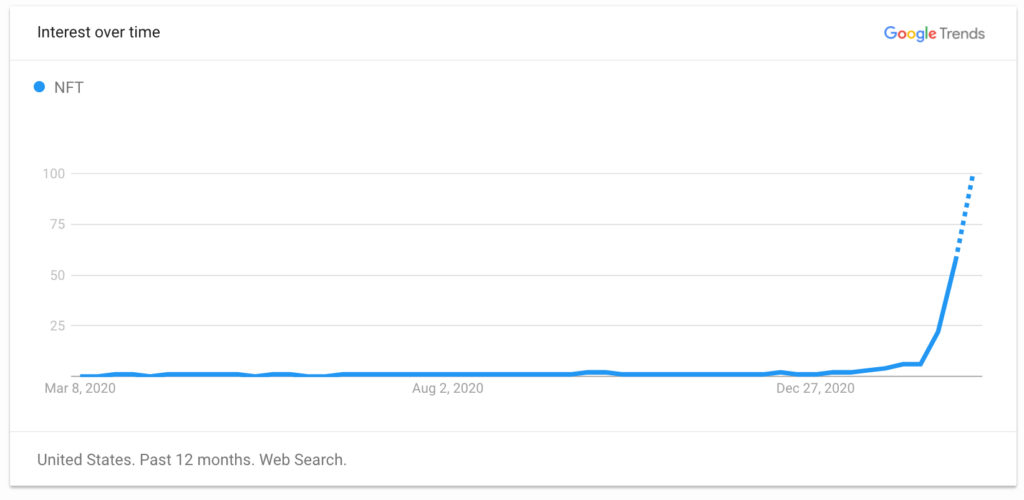
I have to say, when I started to write this article, my knowledge about NFTs was bound to a few tweets I've seen and nothing more. I've read enough about blockchain when it first started to pick-up, so I do have a basic understanding of how it works. That being said, I love researching new topics and breaking them down into simple and digestible content, so I hope this helps. The Stereofox Chief Tech Officer, Darius, is also going to help me as he is much more knowledgeable on the topic.
If you have no idea how blockchain works, I picked a short, but very insightful video that goes into the basics and I think you should start here:
Stay up to date.
New music and exclusive updates in your inbox weekly.
What are Non-fungible Tokens (NFTs)
I'll adopt my favourite ELI5 approach (Explain Like I'm 5). Mona Lisa is a unique, one-of-a-kind piece of art. You can go to the Louvre and see it. Yes, you can download an image from the Internet or print a poster of it for your wall, but none of these mean you actually own the Mona Lisa. The purpose of NFTs is to translate the same concept into the digital world and create scarcity on the Internet when it comes to digital assets by using blockchain technology. Up until now, it has been relatively difficult to say what authenticity and ownership actually mean on the Internet. The culture and the internet itself have been driven by copying, pasting, and replicating without the strong ability to authenticate and display ownership and originality.
But why blockchain? A summary of the video above - in its essence, blockchain is a decentralized alternative to a central database. It stores information in encrypted form using a peer-to-peer network, which makes it difficult to hack or tamper with. It's extremely useful for keeping important records.
Let's continue looking at real-life examples - collectibles like Pokemon, baseball cards, stamps, or old coins. They have value because people enjoy collecting them, find them valuable, and most importantly - there is scarcity around them. Scarcity is the limited availability of a commodity, which may be in demand in the market. That scarcity can drive prices up to and you can end up with cases where a set of Pokemon cards can easily cost $40k.
If you break things down - what's the difference between owning a card, an old coin, an autograph, and owning a digital (and verifiable) asset? Yes, some people might say - "I can download that video or image (digital art) and here we go - I've got it for free." But you can make the same argument with other collectibles - a card is just cardboard. Why is that these items are considered valuable? It's because they are rare and most importantly - because other people actually believe they are valuable. Ultimately it’s not about the actual item whether that's a card, a video, an artwork, or a sound. It’s about the concept of ownership. It’s the concept of what is valuable to a collector.
NFTs serve as a way to digitalize the concept of verifiable ownership and scarcity on the Internet for a variety of assets such as virtual collectibles, in-game items, virtual assets, digital artwork, videos, and so on.
To NFT, or not to NFT…
— Com Truise (@comtruise) March 2, 2021
NFTs (non-fungible tokens) are digital certificates that authenticate a claim of ownership to an asset, and allow it to be transferred or sold. As mentioned before, these assets vary all the way from artworks, sounds, and digital installations, to random (and seemingly useless) stuff like virtual cats.
The term non-fungible is at the core of everything and what differentiates NFTs and cryptocurrencies. In economics, fungibility is a particular characteristic of goods which means that each individual unit is interchangeable and indistinguishable from each other. A great example of this is a dollar bill. You, dear reader, can give me your 50 dollar bill and exchange it for mine and it wouldn’t matter. Non-fungible goods or commodities (AKA not able to be replaced) on the other hand - lioke a collector’s baseball card or a painting, are the opposite. Two paintings from the same artist do not cost the same amount and are not interchangeable.
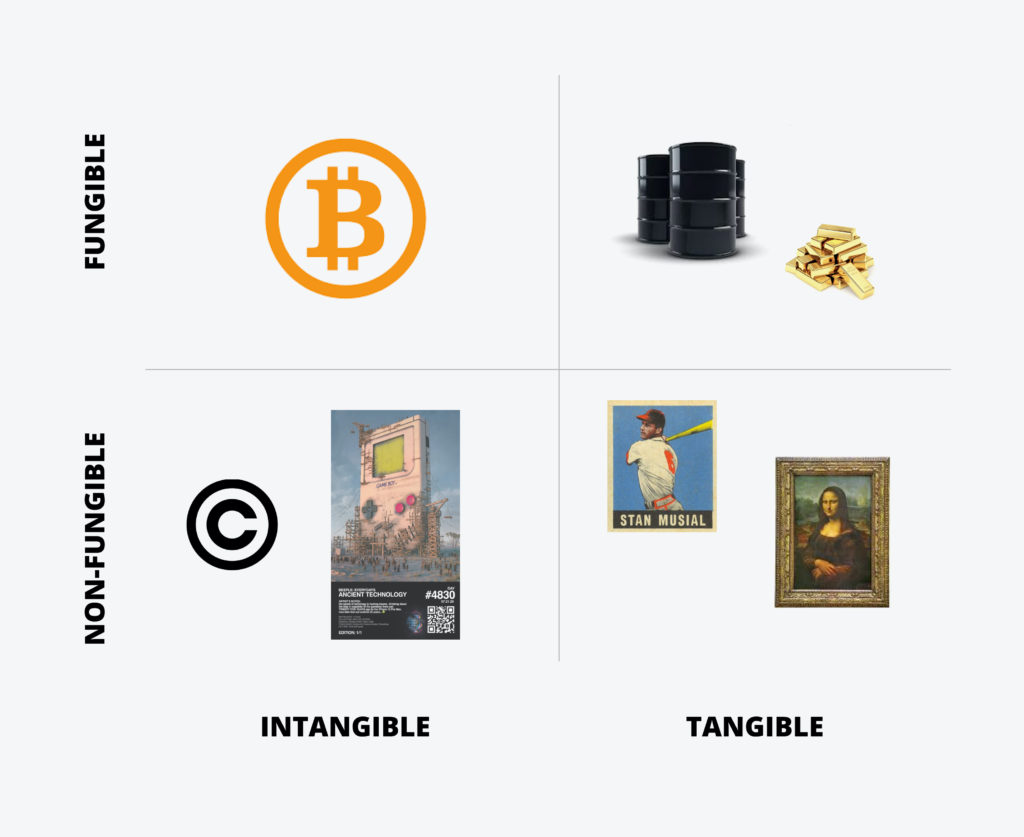
Right now there's a lot of buzz and craze about NFTs, people are definitely speculating, simply trying it out as it's a novelty or jumping on the hype train. Let's be honest - the prices seem insanely obnoxious and I hope they will eventually settle down because now it feels a bit blown out of proportion. I think if this does not happen, the whole thing is just unsustainable, regardless of how innovative the approach.
That being said, I think that the technology behind it is here to stay and as digital art grows in popularity, there might be a need to create scarcity out there. Maybe not for most of us, but for some people out there... Until we live in a world where society is hugely divided when it comes to financial capabilities... there will be those people who find all of this valuable.
Once you start reading on the topic, you will quickly (and with no surprise) find 2 very polar camps. Some consider the "stupid money" being paid for NFTs nothing more than just anotherspeculative bubble that will soon pop. For others, it means new ways for artists to get paid.
NFTs Explained with Examples
NBA was making money on cardboard trading cards with different players and highlights. Then a company called Dapper Labs came along and offered them to use blockchain technology in order to create scarcity for digital assets similar to those real-life cardboard trading cards. The system called Top Shot works like trading cards, only with NBA highlights and digital artwork. So far the product generated over $230 million in gross sales. In a nutshell, it is a way to digitalize a real-life scarcity product and offer investors and collectors to own a unique and scarce item. The best part of this all? Even if somebody makes a perfect copy of the highlight video in the Top Shot you purchased, it will instantly be recognized as a fake.
? TOP COLLECTOR ALERT ?
— NBA Top Shot (@nba_topshot) September 29, 2020
This is 1️⃣ of 4️⃣9️⃣ LeBron James Moments that can ever be minted in our Cosmic packs. Scooped up by user rapid_goji_berry2079 via the #NBATopShot marketplace ?
Start collecting Moments like these before the beta opens! https://t.co/S4XvtARyar ?⛓ pic.twitter.com/Lqm8grEIF1
If an artist puts their NFT-based art up for sale, someone could purchase a unique token that represents the asset and prove authenticity/ownership through blockchain. A great example is the work of creative artist Bosslogic who created an NFT called Forever Mamba (R.I.P., Kobe). I actually saw this visual last year but had no idea it had been digitalized as NFT.
Here's where I thought to myself - well, what's stopping me from downloading the video? True, true... but again - what's stopping me from downloading a picture of the Mona Lisa and putting it on my wall? Yeah, it will be physically there, but it won't be the original... and this is what this whole thing is all about.
A question I had at this point of my research was how do I actually display or share my collection (if I would own one). A lot of the marketplaces where you buy NFTs allow you to digitally display your collection (like a fancy Instagram kinda way) or people nowadays buy physical displays that can be placed on a wall for example and rotate your digital collection.
If you don't think the NFTs market is big yet, according to nonfungible.com by the time of writing this paragraph, there are 5,349,805 sales with a volume of $362.275.313,69 USD. We will dive into the art space further down this piece. Another source I've used to check generic data is cryptoslam, if you like to explore a bit more for yourself.
OpenSea, a marketplace for NFTs, had reported selling $US86.3 million worth in February, a 10x growth from the numbers reported in January.

Properties and Benefits of Non-fungible tokens (NFT)
As mentioned before NFTs run on the blockchain which allows decentralized documentation of transactions, ownership, and the validity of assets. A huge benefit is the fact that NFTs also allow creators to be paid royalties as their content is distributed and re-sold on the internet.
The true reason why NFTs are becoming so popular is engraved in those specific and unique properties and characteristics. I think this is when I truly understood why this system is interesting to a lot of people.
- Unique - each token has a different set of properties stored in its metadata, making it distinct from all other tokens from that type
- Scarce - the original issuer sets and limits the number of NFTs that exist out there
- Indivisible - most NFTs cannot be split into smaller parts, so you can’t buy a fraction of a specific NFT
- Verifiable - the number of tokens and their origins can be verified on the blockchain, hence its provability
- Easily transferable - the number of secondary markets where NFTs can be bought and sold is rapidly raising
- Indestructible - due to their existence on the blockchain and thanks to something called smart contracts
The unique aspect of NFT lies within the fact that each one contains distinguishing and unique information, hence no two NFTs are identical. This is a permanent record that describes what this particular NFT represents. A real-life example would be the authenticity certificate you obtain when buying a painting.
The scarce aspect stems from the fact that the issuer can limit the amount of the NFT available out there with 1 being an extreme case. I'll share a few of those below.
NFTs are indivisible and cannot be broken down into smaller denominations. They exist exclusively as a whole item. Like buying a cinema ticket... it's not like you can buy half a ticket, right?
The information they carry in the token's metadata not only makes them unique, but easily verifiable. The creation or circulation of fake NFTs is pretty much useless as blockchain technology makes it possible to be traced back to the original creator (i.e. digital artworks). Fraud-proof AF. I like the example of flight tickets that are paired to the purchaser's identity. They not only contain your name (maybe even ID number) but date and destination, which makes it very difficult to be traded with each other.
Lastly, royalties can also be programmed into NFTs. What does this mean? The creator/original issuer can receive a percentage of sale profits each time their work is sold to a new owner. As an artist, you don't get exploited by making something awesome, and rich people start trading it with each other and making money. Because it is on the blockchain, all records are perfectly kept, and everything is public on the Internet and recorded. It is a perfect way to pay royalties to the creator.
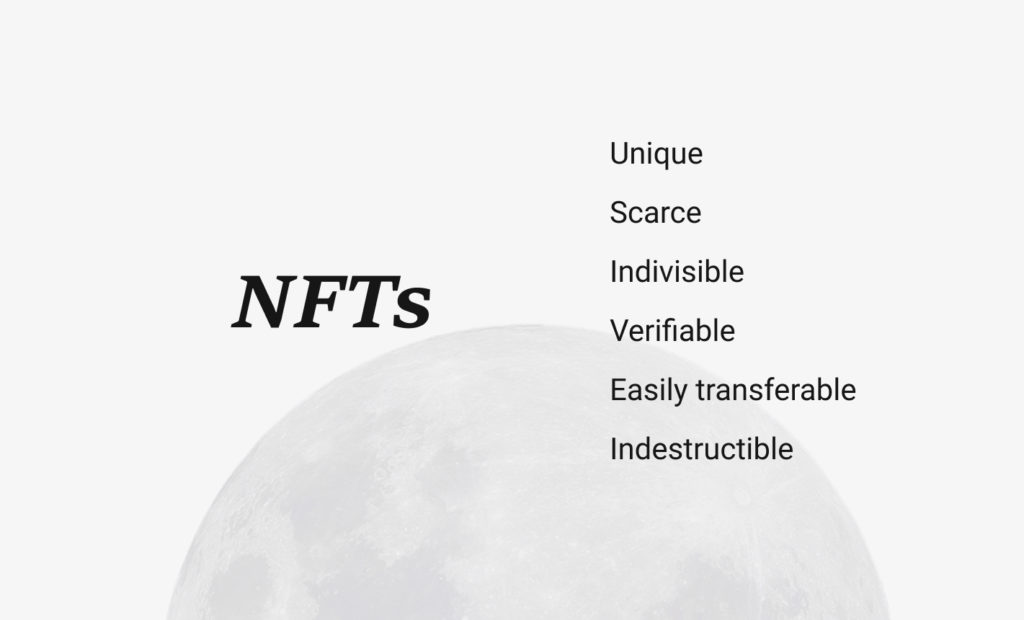
Why are NFTs valuable?
What is the actual point? What the fuck? Why do people invest in NFTs? Who can pay $300k for... and a few more.
A few weeks ago I was asking myself these exact questions and was wondering why should I even care about this. Well, let's talk about two best friends - supply and demand - the key market drivers when it comes to the value of assets, goods, and commodities.
Given the fact that NFTs are scarce in their essence, and the high demand generated by investors and collectors, people are ready to pay a lot of money for them. The world we live in is also a contributor to the importance of NFTs. Given the global mistrust in financial systems, actors in the markets are more likely to be interested in new forms of transaction and open to new ways of being able to invest their money. With BTC (Bitcoin) and ETH (Ethereum) constantly setting price records and investors looking for new places to allocate capital, the crypto art movement is seen as a way to give power back to the creatives.
In addition, NFTs (digital art and digital collectibles) bring quite a few unique benefits to the table. All of that makes them something you should probably care about (as an artist) or if not at least understand how the whole system works.
Lastly, NFT's value comes in with popularity and that popularity is currently driven up by high adoption by crypto users and gaming companies alike because of the way they revolutionized the collectibles space - from art to items in various games with the most famous example CryptoKitties and Pudding Daintytot - a… "cryptokitty" that is on sale for $1 M. Yeah, let that sink in.
The more I read on the topic, the more I feel that the surface has barely been scratched when it comes to what can be created with this technology and how it could spill to other industries beyond arts. I also think that a lot of people who are into cryptocurrency will put extra effort into NFTs as they seem to be a way to encourage mass adoption.
Impact of NFTs on the Music and Creative Industry
Streaming changed the way we consume music and it looks like NFTs could be a driving force behind digitalizing the world of art and collectibles. Someone asked me what's the difference between buying music online and NFTs and I found this quote from Shara Senderoff (Raised In Space) from her talk with music.ally and I feel it belongs here:
"It’s the ability for a fan to purchase an asset that is scarce, that is limited, that is exclusive, and has potential offerings tied to that that make them as a loyal fan feel unique, feel rewarded."
NFTs seem like a plausible solution for artists to provide proof of ownership, authenticity and eliminate issues of counterfeiting and fraud. While a lot of the currently hyped examples are artists with a large audience, I believe NFTs and the ability to directly get support from fans could be an opportunity for independent and smaller artists. That being said, I think being consistent and building your own brand is now more important than ever. Not only it is a way to stand out from the crowd, but also a way to add value to your work. The examples of artwork and visual successes in NFTs enhance the importance of pairing your music with the right visuals when possible. I am aware that not everyone can afford to commission a designer, but it is something worth investing in once things gain traction.
We can't talk about the impact without assessing the volume of NFTs and crypto art. I believe this graph says more than a thousand words.

After all of that, I still want to stress once more - NFTs are not a silver bullet and it's not something that will completely change the game. Artists still have numerous ways to reward their most dedicated fans as their music and art are still going to be public. The patreon model isn't going anywhere and there are other real-life examples of doing something similar to NFT in case this path doesn't feel right for you.
I thought of the case of issuing 100 limited hand-written vinyl for example. Selling them to your most dedicated fans and sending a note/autograph or even a special certificate with the purchase. Again, the main thing NFTs do is just translating that principle into the digital world.
How Artists Use NFTs - Examples
If things are a bit confusing by now - don't worry. You are not alone. I hope sharing some examples helps you understand this better. I've picked some more prominent examples from both the music and digital art scene.
RAC
RAC was actually the first time I heard about NFTs. Back then I ignored it, but I can't remember why. It might have been a combination of inability to understand the topic back then and being busy. Anyhow, his drop was called Elephant Dreams and it is an audio/visual collaboration between Andrés Reisinger and him. It was done on a platform called superrare where each NFT can be only in one copy making it truly unique. On SuperRare's website, it says Edition 1 of 1. On the platform, you can even track who is the current owner of this piece. It was sold for $26,185.

Gramatik
Gramatik has been a vocal supporter of blending tech and music since forever, so this came as no surprise. 2 weeks ago Denis did his first NFT releasing 2 new tracks on Nifty Gateway - "Purple Queens" and "The Ghosts Of Piran".
it’s absolutely fucking mindblowing how a 5 minute NFT auction just replaced the devastating loss of income that came with not being able to tour for a year, I hope this paves the way for all my homies in the music world who are struggling right now to be able to do the same ?
— Denis (@Gramatik) February 20, 2021
The drop covers animated visuals and the tracks itself and has generated over $1.5 million in sales acording to a tweet by Nifty Gateway.
3LAU
3LAU is another strong Internet supporter of the blockchain/crypto technology. When releasing his single "Everything" on Jan 22nd, the New York-born artist dropped an NFT which allowed buyers to receive both the digital artwork, the sound, and a physical visualization of the song in the form of a sound block as shown in the image below.
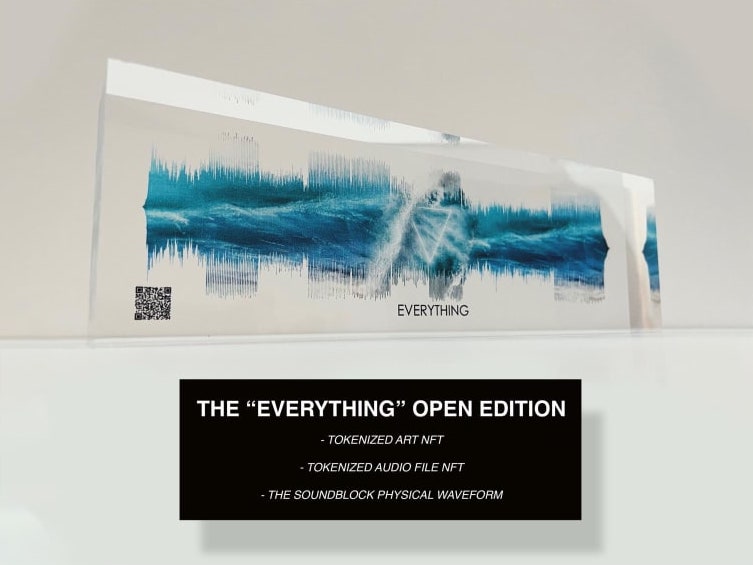
Two Feet
Last on my music list is Two Feet who we interviewed back in 2017 and whose music has been quite popular on the website ever since we featured him for the first time. Zachary teamed up with visual artist FEWOCIOUS and according to sources I've found, the guys have generated over $1M from their first drop.
The difference in this particular case is that the NFT and the collaboration between the two had been organized by an external party - Illumino which is an NFT agency that aims to match musicians and visual artists. I definitely see this as a huge potential in the near future.
Welcome to the 1 Million+ club @fewocious @TwoFeetMusic @illumino_art. $1,015,181 in primary sales makes this drop the highest of the year on @niftygateway.
— The Blockchain Review (@blockreview_) February 15, 2021
Only @beeple @muratpak & @trevorjonesart have achieved this sales milestone before. pic.twitter.com/MOOfMBQWUB
Mike Shinoda
Two weeks ago Linkin Park's Mike Shinoda via NFT auction. Why is this a huge deal? He is actually the first major-label artist to do that. The auction was of a 75-second clip of the track, accompanied by Shinoda’s own animation of artwork by contemporary artist Cain Caser. There were 10 copies of the NFT and you can check who collected them on Mike's Zora profile.
Maddog Jones
I'm moving away from the world of music in order to showcase a few other examples and case studies. Maddog Jones is someone I've been following on Instagram for years now. His cyberpunk/post-apocalyptic style of art are pretty recognizable and he has accumulated a huge following throughout the years.
So far he has done 6 collection drops one of which is with deadmau5. Right now I will use 2 terms I explain a bit further, but I hope it all makes sense. For his latest NFT drop, Maddog did 2 different types of drops. The first one called Boardwalk was an auction where a single piece of unique art was sold for $388k.
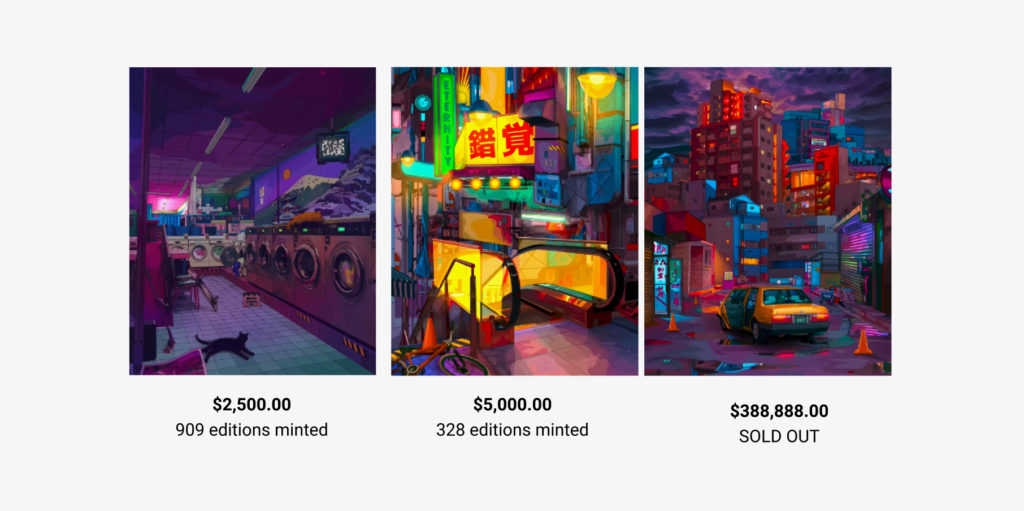
The second one was what people call open edition where potential buyers have a limited amount of time to purchase an NFT. Each edition purchased is referred to as minted. After that time period (5 minutes, in this case) no one else could purchase the NFT, so what it means is that buyer's behavior is defining how scarce a unit is. If you see from the screenshot below Why would I care I'm just a cat has 909 NFTs being bought while Déjà Vu - 328. This means that that's the number of those NFTs that would ever exist because that's the number that was initially minted (a term which I guess means created during a drop). Each of these minted editions has a unique serial number and is identifiable (again, thanks to the technology that's underlying NFTs).
Beeple
Wrapping this up with a guy who really blew me up and I feel is the leading example when it comes to NFT. Naturally, I had no idea about his work before writing this piece, which showcases how much I've been living under a rock since the beginning of the pandemic. Either way, I highly encourage you to browse through his work because the dude is phenomenal, to say the least.
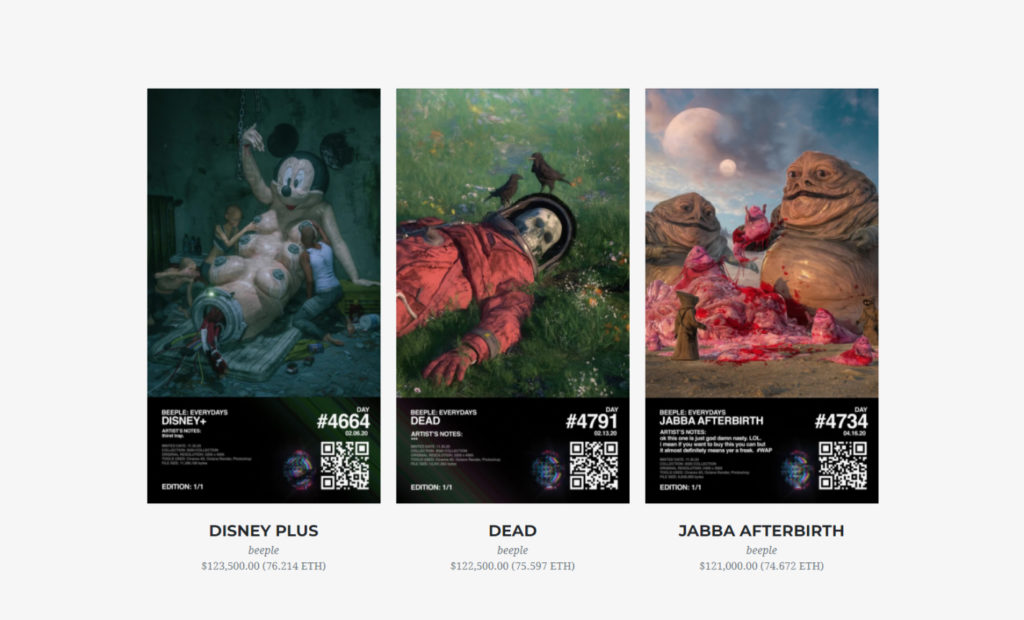
His Everydays project aims to inspire other artists. For 5056 consecutive days (so far), Mike Winkelmann has been doing a visual a day. I mean, that right here is pure dedication. Also, pretty much every visual is like... Woah.
Here's a video from Reuters on a video he created that sold for $6.6M.
A 10-second video clip sold for $6.6 million: A new type of digital asset known as a non-fungible token (NFT) has exploded in popularity as enthusiasts and investors scramble to spend money on items that only exist online https://t.co/2wrD4iFdkS pic.twitter.com/3St8ERSllo
— Reuters (@Reuters) March 1, 2021
The number of artists exploring these options is growing by the minute. Flume, Chet Porter, Yaeji, and Mura Masa are just a few of the mainstream names who are looking into NFTs.
'Saccade' the first in a series of NFT’s from @JonathanZawada and I. View the full piece on @withFND and for info on the next drop sign up at https://t.co/RAD4CHWbfW pic.twitter.com/UXT8KvoKMB
— Flume (@flumemusic) March 4, 2021
Besides tokenized sounds and addition perks, there are cases where artist actually sell the publishing rights via NFTs. That's the case with Jacques Greene's new track "Promise".
This platform is a promise. You can buy the copyright here. In purchase you will own the publishing to the song, but I reserve the right to approval. That’s the promise.
— jg (@jacquesgreene) February 21, 2021
Where to start? Basic Terms and NFT Market Places
Before starting with NFT, there are a few more terms to be familiar with like the types of releases.
- Auctions - self-explanatory - bids can be public or in silent
- Drawing - raffle where you sign up for and only are charged if you are chosen
- Open Edition - they are time-bound meaning an unlimited amount of NFTs can be purchased for a limited amount of time
NFT Market places - differences
- Nifty Gateway - "the Premier Marketplace for Nifties" ...I feel that's one of the most popular marketplaces. It does have a filter, so not everyone can create NFTs on there and it allows you to buy with both crypto and credit card.
- SuperRare - as the name suggests it only allows Auctions of unique items (1 of 1s). Needless to say - heavily curated.
- OpenSea - like eBay for crypto collectibles... pretty much anyone can create and buy NFTs on there, but there isn't much filtering going on, so lots of really, really random things on there.
- Zora - where Yaeji sold her digital pet fish
- Rariable - similar to OpenSea.
Is There A Dark Side Of NFTs?
I must admit I am very confused when it comes to writing this part. There are two polar opinions on whether or not crypto art is damaging the environment... and yes, that seems to be the dark side of NFTs. Actually, it all seems to be rooted in issues related to cryptocurrency and blockchain technology, so it's not solely bound to NFTs.
I've read a few articles on the matter but 2 I wanted to highlight (one from each camp) are HERE IS THE ARTICLE YOU CAN SEND TO PEOPLE WHEN THEY SAY “BUT THE ENVIRONMENTAL ISSUES WITH CRYPTO ART WILL BE SOLVED SOON, RIGHT?” and No, CryptoArtists Aren’t Harming the Planet. However, I need to point out the fact that the latter is written by SuperRare.
The issue seems to lie within Ethereum’s carbon emissions, an issue that surrounds crypto and blockchain as a whole. The main argument pointed out is that minting & trading NFTs does not increase as Ethereum has a fixed energy consumption at a given point in time. That's great, but of course not enough to wave off the potential issue... I totally get that. I think the problem might be the increased adoption of the technology rather than the associated emission impact of NFTs. Right now some people (as far as I know, SuperRare) are using carbon emissions offset to counter that, but as far as I know, there is work being done by the crypto community to tackle that issue.
In full disclosure, we are considering trying NFT as a label - not sure if it would be anything more than figuring out how this thing works from the creator's standpoint, but that's where we're at. The research and study on the topic will continue, and I hope this is a useful article that reflects my understanding on the topic.




